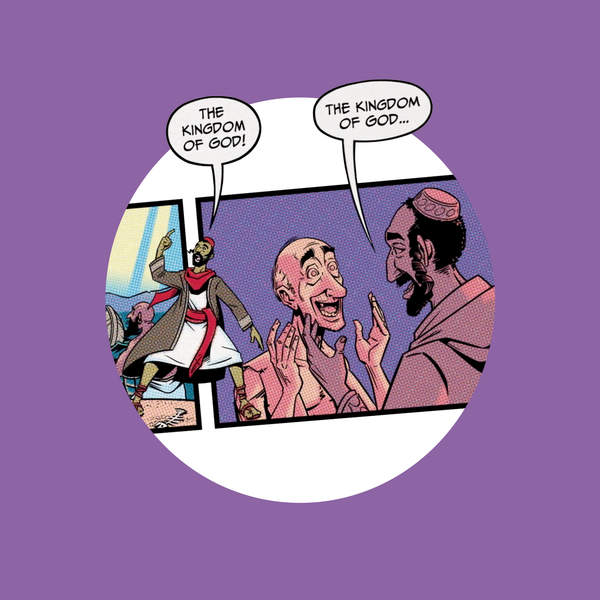
Why Are There Four Accounts of the Gospel?
Episode Chapters
Show Notes
Key Takeaways:
- The four gospels all tell a unique perspective of the same story. They all claim Jesus is the Jewish Messiah who fulfills the Hebrew Scriptures.
- Mark is widely considered to be the oldest Gospel.
- The genealogies at the start of Matthew have hidden design patterns in them that unify the Old and New Testaments.
- The story of Zacharias and Elizabeth at the start of Luke is meant to layer onto the story of Abraham and Sarah in the Old Testament. This is a key design pattern of Luke. Luke likes to create the characters in his book based off Old Testament figures.
Quote:
“(The gospels) are constantly and from the first moment tying the Jesus story back into Hebrew scriptures. There isn’t a story or teaching about Jesus that isn’t packed with Old Testament allusion.” In part 1 (0-5:00), Tim and Jon briefly recap the last episode. Tim says he’s going to unpack four ways that readers can better understand and uncover themes in the gospels. In part 2 (5:00-14:00), Tim dives into advanced ways to read these accounts. One way to take your reading of the gospels to the next level is to get a Bible that shows when a Gospel is citing or quoting an Old Testament passage. For example, Tim focuses on the book of Mark. Most scholars view Mark as the oldest of the gospels. Mark 1 shares links to both Isaiah 40:3 and Malachi 4:5-6 in the first verses. Mark 1:1-3 The beginning of the good news about Jesus the Messiah, the Son of God, as it is written in Isaiah the prophet: “I will send my messenger ahead of you, who will prepare your way”— “a voice of one calling in the wilderness, ‘Prepare the way for the Lord, make straight paths for him.’” Tim says that this should alert the reader to the fact that Mark is heavily influenced by the Old Testament. Mark is reading the Old Testament, and his Gospel is structured around and informed by the Hebrew Scriptures. In part 3 (14:00-22:30), Tim then looks at the start of Matthew. The book begins with a genealogy. This genealogy is broken into three movements of fourteen generations: fourteen from Abraham to David, fourteen from David to the exile, and fourteen from the exile to Jesus. In order to stick to this pattern, Tim notes, generations would have been left out. So why would Matthew use this pattern? There are several thoughts. One is that the number fourteen is the numerical value of the name “David.” So Matthew is disguising his claim that Jesus is a new and better David in this genealogy. Tim also mentions that four women are mentioned in this genealogy. Each of them are non-Jewish women. Again, why does Matthew do this? He wants you to know that Gentile women in the Old Testament played a crucial role in carrying on—and in some cases rescuing—the messianic seed. In part 4 (22:30-32:30), Tim dives into the opening of the Gospel of Luke. The story of Elizabeth and Zacharias is meant to map onto the story of Abraham and Sarah. Both couples are old and have no children or heirs. Luke then moves onto the introduction of Mary. Mary’s response to the angel’s proclamation is different than Zacharias’ response. So Luke uses a lot of character design to overlap Old Testament and New Testament characters in order to show a new act of God. In part 5 (32:30-47:30), Tim dives into the opening in the Gospel of John. There are themes of Genesis 1 (“In the beginning”) and Lady Wisdom from Proverbs 8 in the opening lines of John. Many modern Western readers find John's writing style to be the most approachable and easy to understand. John's links and callbacks to earlier Hebrew Scriptures are more obvious to the untrained eye than in the other gospels. In part 6 (47:30-end), Tim and Jon dive into Mathew 11. Matthew 11:2-6 When John, who was in prison, heard about the deeds of the Messiah, he sent his disciples to ask him, “Are you the one who is to come, or should we expect someone else?” Jesus replied, “Go back and report to John what you hear and see: The blind receive sight, the lame walk, those who have leprosy are cleansed, the deaf hear, the dead are raised, and the good news is proclaimed to the poor. Blessed is anyone who does not stumble on account of me.” Tim says that this passage is heavily influenced by Isaiah 35 because Jesus quotes from this passage to answer John's question about whether he is the Messiah or not. Isaiah 35:1-7 The desert and the parched land will be glad; the wilderness will rejoice and blossom. Like the crocus, it will burst into bloom; it will rejoice greatly and shout for joy. The glory of Lebanon will be given to it, the splendor of Carmel and Sharon; they will see the glory of the Lord, the splendor of our God. Strengthen the feeble hands, steady the knees that give way; say to those with fearful hearts, “Be strong, do not fear; your God will come, he will come with vengeance; with divine retribution he will come to save you.” Then will the eyes of the blind be opened and the ears of the deaf unstopped. Then will the lame leap like a deer, and the mute tongue shout for joy. Water will gush forth in the wilderness and streams in the desert. The burning sand will become a pool, the thirsty ground bubbling springs. In the haunts where jackals once lay, grass and reeds and papyrus will grow.
Scripture References
Referenced Resources
- What Are the Gospels?: A Comparison with Graeco-Roman Biography by Richard Burridge
- Reading the Gospels Wisely: A Narrative and Theological Introduction by Jonathan Pennington
- A brief overview of Jewish history pre-Christ and during Roman rule.
- For more on the different scholarly views on the meaning and background of Lady Wisdom in Israelite history, see Michael Fox's Anchor Bible Commentary: Proverbs 1-9 on pages 331-345 and 352-359.
- Show Produced by:
- Dan Gummel
- Powered and distributed by Simplecast.
Check out Tim's library here. You can experience our entire library of resources in the BibleProject app, available for Android and iOS.

